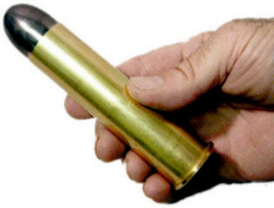The head space statement is absolutely correct ,however the shoulder does more than that even on rimmed and belted cases.Think of a rimmed case . Let's say it has a base dia. of .500 and a neck diameter of .250.We'll make the case 2.5" long with a .500" neck.If the case had no shoulder it would still have head space because of the rimm. With no shoulder the case would tapper from the base dia.at the rimm to where the neck starts.
Now lets take the same basic case. We will say that 1.75" from the rimm the case dia. is .450. We have a gap .250" gap from the .450dia. to the .250 neck diameter.Filling in the gap creates the shoulder. Right away you can see that you have increased the powder holding capacity substantially. That's another thing the shoulder does.
Comparing in our mind the two cases we've created we have a slender sloping no shoulder case and a plump shouldered case.
When the smaller amount of powder in the slender case is ignited it tends to funnel the powder and gases out to the barrel. It offers no restriction to flow that would help to increase pressure as the bullet leaves the case.
Igniting the larger amount of powder in the plump case creates a different scynario.There is more powder(greater energy)and instead of being gently funneled it is greatly restricted and hammered by the shoulder and tends to significantly increase pressure and temperature as the bullet leaves the case. It can be said than that the shoulder generates more efficient burning of the powder. The yield of course is that the shouldered case is capable of obtaining much higher velocities than it's shoulderless slender brother.
The shoulders functions:
1. head spacing
2. facilitates greater powder capacity
3. Creates turbulance that promotes more efficient energy release of the powder.
There are others such as the aiding to belt ammo for machine guns.But getting into the minutia I'm sure isn't what you are after.

roger


 The Accurate Reloading Forums
The Accurate Reloading Forums  THE ACCURATE RELOADING.COM FORUMS
THE ACCURATE RELOADING.COM FORUMS  Rifles
Rifles  Wildcats And Their Development
Wildcats And Their Development  Re: Why do cartridges have shoulders?
Re: Why do cartridges have shoulders?







 roger
roger
 The Accurate Reloading Forums
The Accurate Reloading Forums  THE ACCURATE RELOADING.COM FORUMS
THE ACCURATE RELOADING.COM FORUMS  Rifles
Rifles  Wildcats And Their Development
Wildcats And Their Development  Re: Why do cartridges have shoulders?
Re: Why do cartridges have shoulders?

